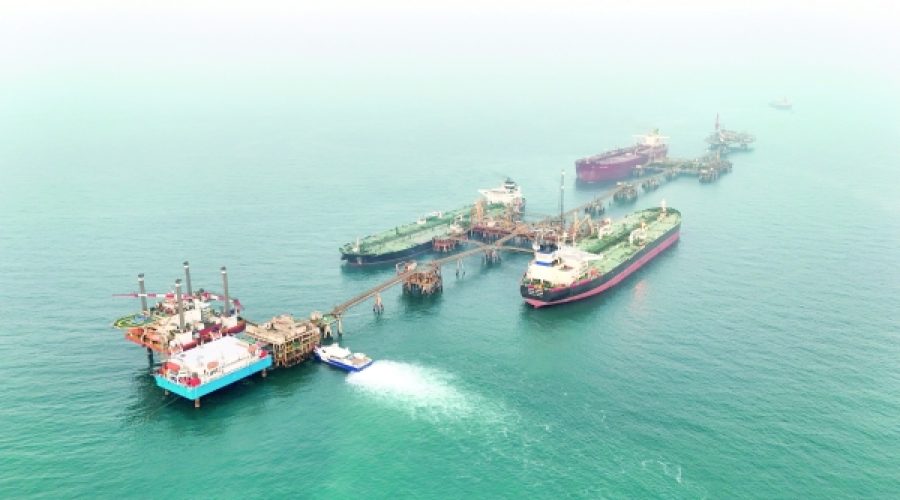ارتفاع إمدادات النفط يؤدي إلى تضييق هيكل الأسعار وانخفاض أقساط التأمين: ما يعنيه ذلك للمستثمرين والشركات في عُمان
لندن (رويترز) - قال متعاملون ومحللون يوم الخميس إن أقساط التسليم الفوري لمعايير النفط العالمية الرئيسية تتراجع نسبيا مقارنة بأسعار الأشهر المقبلة، مدفوعة بزيادة الإنتاج من الشرق الأوسط وأميركا اللاتينية وأوروبا، إلى جانب انتهاء ذروة الطلب في الصيف.
كما أن تراجع المخاوف بشأن فرض عقوبات أميركية جديدة محتملة على روسيا، والتي قد تؤدي إلى تعطيل إمدادات النفط، يضغط أيضا على أسعار النفط.
منذ بداية أغسطس، تقلصت فروق الأسعار لستة أشهر لعقود برنت، وخام غرب تكساس الوسيط الأمريكي، وخام دبي الشرق الأوسط الآجلة بأكثر من $1 للبرميل، نتيجةً للتراجع. التراجع هو حالة سوقية تتجاوز فيها أسعار التسليم الفوري أسعار الأشهر المقبلة، مما يشير إلى نقص في المعروض؛ ويشير تقلص الفارق إلى توقعات بارتفاع مستويات العرض.
قال شهروه زوخريتدينوف، تاجر نفط مقيم في دبي: "تتراجع فروق أسعار برنت ودبي بشكل رئيسي نتيجةً للزيادات التدريجية المتوقعة في إنتاج أوبك+ اعتبارًا من سبتمبر، وتراجع المخاوف من انقطاع الإمدادات الروسية بعد استمرار التدفقات عبر البحرين البلطيق والأسود". وأضاف أنه في حين يظل إنتاج الخام الأمريكي مستقرًا، من المتوقع أن ينخفض نشاط المصافي تدريجيًا مع اقتراب موسم الذروة، مما سيقلل من شح الإمدادات الفورية.
يهدف الاجتماع المرتقب بين الرئيس الأمريكي دونالد ترامب والرئيس الروسي فلاديمير بوتين في ألاسكا يوم الجمعة إلى التفاوض على اتفاق لوقف إطلاق النار في أوكرانيا. وأشار محللو سيتي إلى أن خام برنت قد ينخفض إلى أدنى مستوى له عند $60 للبرميل في حال التوصل إلى اتفاق بين الولايات المتحدة وروسيا.
ارتفاع العرض ونهاية ذروة الطلب
يستعد المشاركون في السوق لزيادة الإمدادات بعد أن اتفق أعضاء أوبك+ على زيادة الإنتاج في سبتمبر، بالتزامن مع زيادة الإنتاج من منتجين من خارج أوبك مثل غيانا والبرازيل والنرويج. إضافةً إلى ذلك، يُخفّض انتهاء ذروة الطلب الصيفي في نصف الكرة الشمالي هوامش ربح الديزل القوية سابقًا في أوروبا، ويُخفّض استهلاك النفط الخام لتوليد الطاقة في المملكة العربية السعودية.
وقال هاري تشيلينجويريان، رئيس قسم الأبحاث في مجموعة أونيكس كابيتال، في إشارة إلى ظروف التداول الفعلية في بحر الشمال: "لاحظنا عمليات بيع كبيرة خلال الفترة، مما يعكس مراجعات نزولية في توقعات الطلب على النفط الخام مع ضعف هوامش المصافي وانهيار فروق أسعار الغازولين والديزل".
بشكل منفصل، أعلنت شركة تطوير مزارع الرياح الدنماركية أورستيد يوم الاثنين عن خطط لإصدار حقوق بقيمة $9.4 مليار دولار، مشيرة إلى التحديات في قطاع الرياح البحرية في الولايات المتحدة.
وأضاف تشيلينجيريان: "مع تراجع الطلب الموسمي وعدم اليقين بشأن قدرة الصين على الحفاظ على الواردات المرتفعة للتخزين، يبقى السؤال: أين سيتم استيعاب البراميل السعودية الإضافية؟"
استقرت علاوات الأسعار الفورية لخامي الشرق الأوسط المرجعيين، دبي وعمان، عند أدنى مستوياتها منذ أكثر من شهر للشحنات المُحمّلة في أكتوبر. ومع ذلك، لا يزال خام دبي أقوى نسبيًا من خام برنت، مما يُبقي فارق السعر بين هذين الخامين المرجعيين ضيقًا، ويسمح بإعادة توجيه إمدادات حوض الأطلسي نحو آسيا.
تمكنت شركات التكرير الآسيوية بالفعل من تأمين ملايين البراميل من الولايات المتحدة وأفريقيا وأوروبا للتسليم في شهري سبتمبر وأكتوبر.
أشار نيل كروسبي، المحلل في شركة سبارتا كوموديتيز، إلى استمرار حالة عدم اليقين المحيطة بالإمدادات الروسية، حيث اشترت الهند - ثالث أكبر مستورد للنفط في العالم - مؤخرًا شحنات فورية لاستبدال النفط الروسي. وقال: "سيتم تحويل بعض خام الأورال إلى الصين، لكن الوضع لا يزال دون حل، مع استمرار المخاطر المتعلقة بالنفط الروسي غير القابل للبيع، مما يجعل تداولات عقود المبادلة الآجلة (EFS) أكثر تعقيدًا من المعتاد".
— رويترز
تحليل خاص من عمانت | تصفح سوق عُمان
يشير التراجع الأخير في علاوات النفط العالمية وسط ارتفاع إنتاج الشرق الأوسط وتراجع التوترات الجيوسياسية إلى تحول نحو زيادة العرض واعتدال الطلببالنسبة للشركات العمانية، تمثل هذه البيئة تحديًا يتمثل في انخفاض إمكانات عائدات النفط وفرصة ل التنويع في الطاقة البديلة والقطاعات اللاحقةينبغي للمستثمرين الأذكياء مراقبة قرارات إنتاج أوبك+ والتطورات الجيوسياسية عن كثب، وتحديد المواقف المرونة طويلة الأجل بعد دورات ذروة الطلب على النفط.



